Celebrating Dia de los Muertos, Day of the Dead, with Master Baker Alex Pena’s Pan de Puerto
(Gerry Furth-Sides) Master Baker, Alex Peña’s Dia de los Muertos holiday bread, Pan de Muerto, may look like dough but literally feels like a cloud. It is considered an honor to be given this confection, decorated with skulls and bones, and sprinkled with sugar or covered in sesame seeds depending on region home, on the ofrendas or alter, along with the statuettes of life and death, one on each side. His would be on the altar.
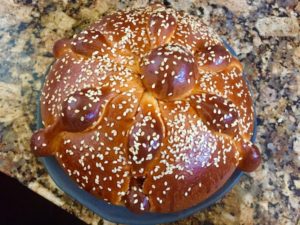
Master Baker alex Pena’s sesame-covered Pan de Puerto. The topping of sesame seeds or sugar depends on the regions of Mexico or Latin America
Dias de Los Muertos is a traditional holiday reuniting and honoring beloved ancestors, family and friends who have passed away. On November 1, children who have passed away are celebrated. Adults are celebrated on November 2. The bread and other treats they loved in life are set out on the altar so they can “taste” them again when they return home for a brief visit.
Peña grew up making bread. His eyes lit us as he told us that the first thing he remembers doing as a kid is decorating cakes. And he has loved it every since. Alex worked with his dad and his brothers at La Morenita Bakery in greater Los Angeles, now closed. Alex’s dad was a Renaissance man of many talents, who was equally at ease playing esoteric classical instruments as he was baking, so gatherings of friends and family always meant wonderful music as well as food. This feeling remains with Alex the minute you meet him.
These days, Master Baker Peña wears not an apron but a white lab coat. He is director of research and product development for Bellarise yeast. The international company based in Turkey supplies an organic yeast plus other ingredients for industrial baking. The name on the company door is Pak Group, the fourth largest yeast company in the in the world. However, you can still buy pan de muerto at Panaderías and Latino markets.
Dia de los Muertos (Day of the Dead) goes all the way back to the Hispanic cultures of Miso-America of the indigenous people, including the Aztecs and Mayans. However, this bread dates from the 1940s, created by Basque bakers who settled in Mexico City. In fact, Basque bakers originated the bakeries in Mexico. Basque immigrants from the province of Navarre, Spain first became a presence. They arrived from the Spanish Valley of Baztán to live in Mexico City at the end of the 19th and beginning of the 20th centuries. Ultimately, they became the most important European influence on Mexico’s commercial bakeries, flour sellers, and yeast purveyors. Cristina Potter’s rich history of how this took place can be found at: (//mexicocooks.typepad.com/mexico_cooks/2018/05/bakeries-and-their-basque-origins-in-mexico-city-please-wash-your-feet-before-entering.html)
Pan de muerto is simply made of flour, butter, lard, eggs, water, cane sugar, salt and of course, yeast. A unique flavoring employed by the Basques was the very subtle addition of orange flower water instead of the more commonly used cinnamon. Peña also uses a subtle orange flower water, and found in his research that cinnamon slows fermentation.
After mixing the dough, he forms it into rounds and refrigerates them to ferment, which adds flavor and improves the texture. Handmade decorations resemble crossbones with a skull in the center at the top.
The completed loaf ready to go into the proof box, where it develops for 45 minutes to an hour. The bread is placed in the lab’s revolving oven where it bakes for 25 minutes.
Peña paints the freshly baked golden brown breads with melted butter, tshen he coats them with sugar. (see videos below). The custom is to use pink sugar for children and white sugar for adults. Peña varies some of his loaves by sprinkling some with sesame seeds and some with sugar. Different regions in Mexico also each have their own tradition.

The breads are brushed with butter and then sprinkled with sesame seed or finely granulated sugar – “marrying the bread with each ingredients”
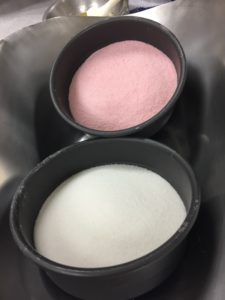
Sugar, is sprinkled on Master Alex Pena’s warm pan de muerto after being brushed with butter, pink for children and white for adults.
Watch Master Chef Alex make the Pan de Puerto on the YouTube show Trippy Food (www.YouTube.com/TrippyFood), hosted by Valentino Herrera

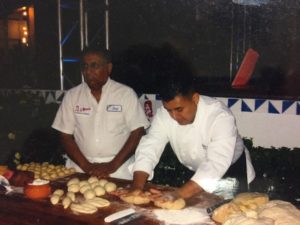

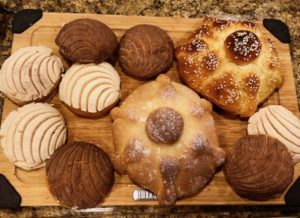
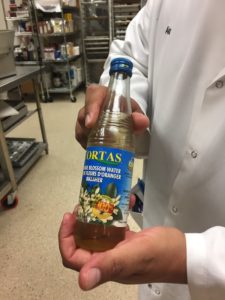
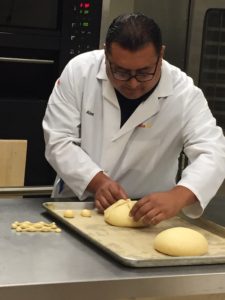
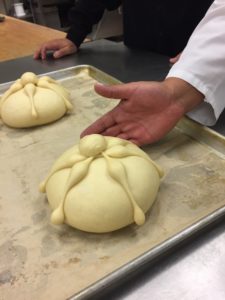


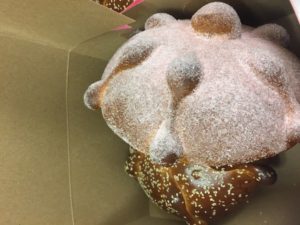
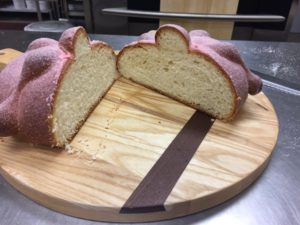
 Gerry Furth-Sides
Gerry Furth-Sides  Barbara Hansen
Barbara Hansen  Chef-owner Alain Cohen
Chef-owner Alain Cohen  Roberta Deen
Roberta Deen  Jose Martinez
Jose Martinez  Nivedita Basu
Nivedita Basu